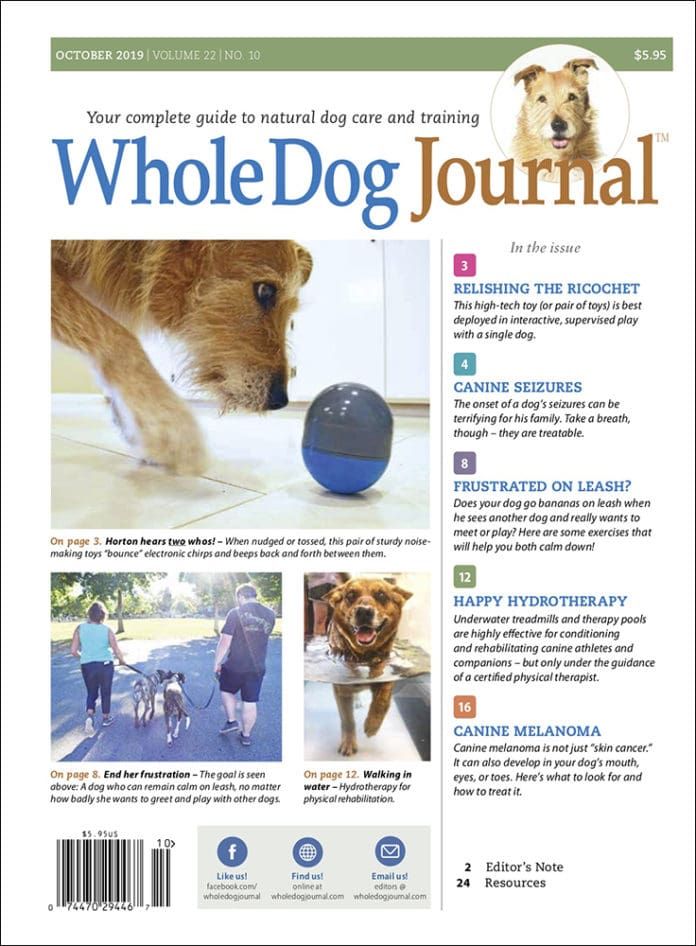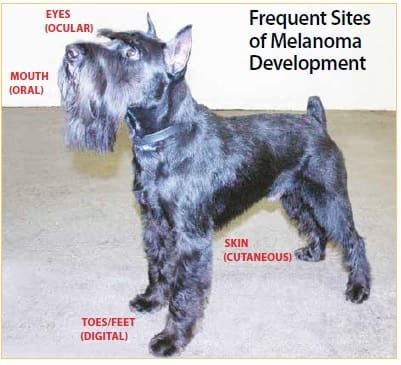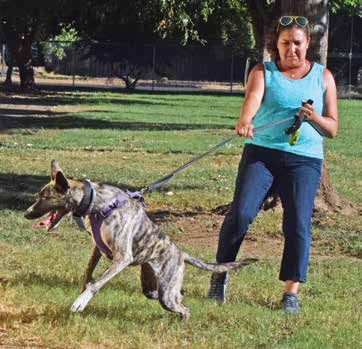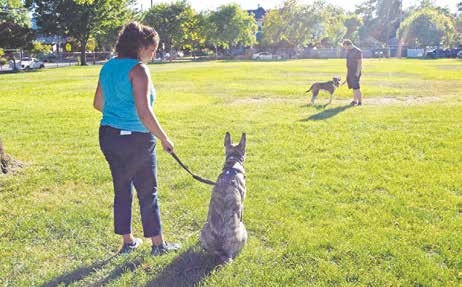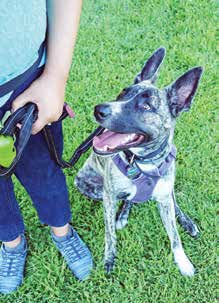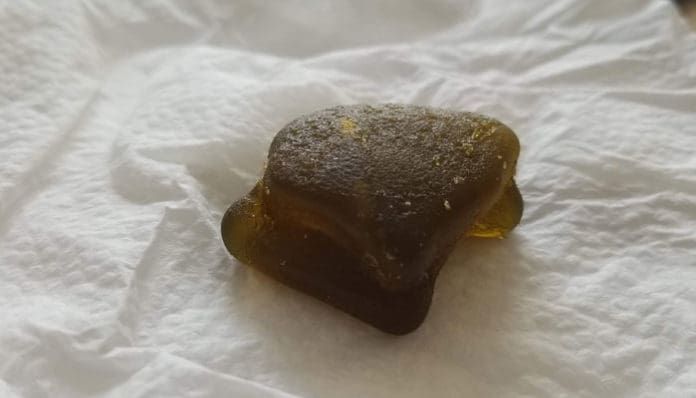- Relishing The Ricochet
- Canine Seizures
- Frustrated On Leash?
- Happy Hydrotherapy
- Canine Melanoma
Download the Full October 2019 Issue
Canine Melanoma
Canine melanoma is the umbrella term for a group of melanocytic tumor subtypes that are so complex and diverse (yet distinct from each other) that they can sometimes seem as if they are different diseases entirely. What all types of melanomas do have in common is that they form when normal melanocytes (cells that are responsible for producing melanin) divide and grow out of control.
Melanomas are classified as either benign or malignant tumors. Fortunately, the majority of melanomas that occur in dogs are benign; this form of melanoma is typically referred to as a melanocytoma. These tumors are not cancerous and usually do not become cancerous, nor do they interfere with the function of normal cells. They will often cease growing once they reach a certain size and they do not invade other tissues. Furthermore, they do not metastasize, and they tend to not grow back when surgically removed.
In contrast, malignant melanomas, accounting for 5 to 7% of all canine melanomas, are highly aggressive and can metastasize to vital organs very quickly. About 100,000 cases of malignant melanoma in dogs are diagnosed in the U.S. each year.
This cancerous tumor tends to form in areas of the body that are pigmented, and while the tumors are usually brown or black, they can appear pink, tan, or even white, depending on the level of melanin being produced. These are most commonly seen in middle-aged to older dogs (average age of 9 years) with no gender predilection.
The location in the body will determine the specific biological behavior of this cancer. Dogs are often asymptomatic until the cancer has spread.
Causes of Melanoma in Dogs
The etiology of canine melanoma is not known, but researchers believe that it may due to a combination of environmental factors and genetics. It is also suspected that chemical agents, stress, trauma, or excessive licking of a particular spot could be factors; if cells are triggered to randomly multiply, it can increase the chance of mutation during cell division and result in the formation of malignant cells.
While ultraviolet light exposure is a major cause of melanoma in humans, it is not usually associated with the canine form due to their protective coat of fur.
Breed Disposition
Malignant melanoma in dogs is thought to reflect a strong genetic component with the following breeds being over-represented: Airedales, Bloodhounds, Boston Terriers, Chihuahuas, Chow Chow, Cocker Spaniels, Dachshunds, Doberman Pinschers, English Springer Spaniels, Golden Retrievers, Gordon Setters, Irish Setters, Pekingese, Poodles, Rottweilers, Miniature and Giant Schnauzers, Springer Spaniels, Scottish Terriers, and Tibetan Spaniels.
The disease is also more likely to appear in the toes or toenail bed of black dogs; small breeds with heavily pigmented mucous membranes in the mouth are reported to be at an increased risk of oral melanoma.
Diagnosis
Diagnosis of canine malignant melanoma is typically obtained through cytology from a fine-needle aspirate of the tumor and/or biopsy and histopathology, but they are also known for being challenging to diagnose.
When melanomas are pigmented, the pathologist can usually see the melanin granules and characteristic cell morphology in the sample. Difficulties arise when melanocytic tumors lack pigmentation and the cell morphology varies tremendously.
The histopathological results of the biopsy may resemble carcinoma, sarcoma, lymphoma, or an osteogenic tumor. At this point, additional testing with special stains for immunohistochemical (IHC) markers (Melan-A, PNL-2, tyrosine reactive protein TRP-1 and TRP-2) is required; this screening is highly sensitive and specific for detecting melanocytes. It is vital to have an accurate diagnosis as that will determine the treatment protocol used and the prognosis.
Further diagnostic tests to assess the dog’s overall health and determine the stage of the disease may include a complete blood count; serum biochemical profile; urinalysis; chest radiographs and abdominal ultrasound to look for evidence of metastasis; and lymph node aspirate to check if cells have spread to the lymphatic system.
In dogs with the oral form of melanoma, especially if the lymph nodes are noted to be enlarged, further testing is warranted to check for metastasis in the abdominal lymph nodes, liver, adrenal glands, and other sites.
For oral tumors, radiographs and/or a computed tomography (CT) scan may be recommended.
Because digital (toe) melanoma often involves bone destruction, radiographs should be taken of the affected foot.
Specific diagnostic techniques for ocular melanoma involve slit-lamp examination, tonometry (intraocular pressure), gonioscopy (exam of the front part of the eye), and fundoscopy (exam of the back of the eye).
Stages of Melanoma in Dogs
The diagnostic tests discussed above will provide the foundation for assigning a stage and grade to the patient’s malignant melanoma.
- Oral malignancies. For these tumors, staging is fairly straightforward and extremely prognostic. While the World Health Organization’s staging system is considered limited in its application (tumor size is not standardized to the size of the patient and histologic appearance and other histologic-based indices are not considered), it is often still used:
- Stage I: Size of primary tumor is less than or equal to 2 centimeters (cm) in diameter with no involvement of lymph nodes.
- Stage II: Size of primary tumor 2 to 4 cm in diameter with no involvement of lymph nodes.
- Stage III: Size of primary tumor greater than or equal to 4 cm in diameter and/or metastasis to lymph nodes.
- Stage IV: Tumor of any size with distant metastasis present.
Alternative staging systems incorporating histologic criteria have been explored, and while a comprehensive approach has unfortunately yet to be developed, these investigations have continued to find that size and location are extremely relevant.
- Non-oral melanoma. The staging system for non-oral forms of canine melanoma is not well defined and further development with clinical variables and outcome is needed.
Histopathologic Grading
There are three histologic features that can be discerned from a biopsy that have been shown to have predictive value. The first, nuclear atypia, is the abnormal appearance of the nucleus of a cell and is considered an indicator of malignancy.
There are several approaches that can be taken to estimate the extent of nuclear atypia, but the assessment is subject to inter-observer variation. It is typically reported as mild, moderate, or severe. Levels greater than or equal to 30% for oral melanomas and greater than or equal to 20% for cutaneous and digit are considered to have poor prognoses.
The second, Ki-67 index, is a quantitative reporting of the cells that are positive for containing the protein Ki-67. This protein increases when cells prepare to divide, and it can be measured with a special staining process. A higher number of positive cells indicates that they are dividing and forming new cells quickly. A Ki-67 proliferative index of greater than or equal to 15% is considered a negative prognostic factor for cutaneous and digital melanomas, as is an index of greater than or equal to 19.5% for oral melanomas.
The mitotic index (MI) is the third and most common feature that can be discerned from a biopsy and is used to estimate the course of the disease. The MI measures the percentage of cells undergoing mitosis (cell division); a higher number of cells that are dividing indicates more aggressive disease. An MI of 3 or higher (out of 10) predicts decreased survival, while an MI of less than 3 predicts a more favorable outlook.
In cutaneous and ocular melanoma cases, the MI is the most reliable element for distinguishing malignant from benign tumors.
[post-sticky note-id=’396308′]Types of Canine Melanoma
In dogs, there are four primary types of melanoma that can occur: oral (anywhere around the mouth or oral cavity); digital/subungal (around the nail bed and in, on, and between toes); cutaneous (skin); and ocular (in and around the eye). Each type has its own clinical presentation and biological behavior.
Oral Melanoma

Melanomas in and around the mouth are considered the most common oral malignancies that occur in dogs. It is estimated that this cancer accounts for anywhere from 14 to 45% of all oral tumors and 80 to 85% of all malignant melanomas.
This form of melanoma typically occurs in dogs ages 10 years and older and in smaller dogs; dogs with heavily pigmented mucous membranes are at higher risk. Tumors can occur anywhere in the oral cavity and surrounding areas, with the majority found in the gingiva/gums. The next most common site is the lips, and then the hard and soft palate. Fewer than 5% develop on the tongue.
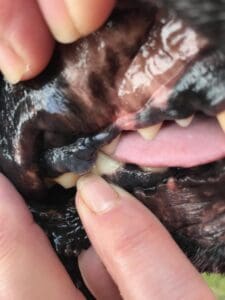
Growths tend to be solitary, appearing as a distinct lump or as a flat plaque-like lesion that may or may not be ulcerated. Tumor colors may vary from black to gray to pink or with varied coloring; up to 33% have no pigment at all. Symptoms can include facial swelling; bad breath/mouth odor; abnormal breathing sounds; difficulty chewing, eating, or swallowing; loose teeth; bleeding from the mouth; excessive salivation; and weight loss.
Malignant oral melanomas are quite locally invasive, often infiltrating nearby tissue and bone. At the time of diagnosis, 57% of cases have radiographic evidence of bone involvement. The likelihood for metastasis is high (80 to 85%) with the most common site being the regional lymph nodes, followed by the lungs and other distant organs.
Digital (Toe) / Subungal (Nailbed) Melanoma
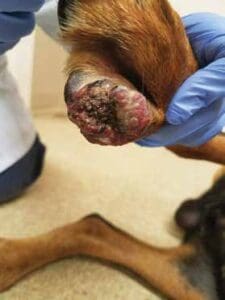
This is the second most common type of malignant melanoma diagnosed in dogs, accounting for 15 to 20% of all melanoma cases and 11% of all tumors involving the digits.
Local invasion is a common feature of this form, with many dogs having evidence of bone damage. Anatomically, the forelimbs are slightly more likely (57.1%) than the hindlimbs (42.9%) to develop a melanocytic tumor.
Dogs with black coats tend to have a higher incidence of the disease. It tends to present as a solitary tumor between the toes, on the foot pad, or on the nailbed, causing swelling of the area and sometimes loss of the toenail.
This type of tumor often develops a secondary infection that can initially misdirect the diagnosis. Lameness is often the first noticeable symptom; swelling with bleeding or discharge from the affected area may also occur, and dogs may lick or chew the area.
Like the oral form of the disease, the digital is extremely aggressive with a dismal metastatic rate of 80%.
Cutaneous Melanoma
This is common in dogs and accounts for about 5 to 7% of all canine skin tumors. These tumors can form anywhere on the skin, and while most are malignant in humans, the majority are benign in dogs.
Benign skin melanomas are usually solitary, small, well-defined, deeply pigmented, firm, and move freely over underlying structures. The malignant form varies considerably in appearance, regardless of the location, and is usually asymmetrical. The color is variable, ranging from gray or brown to black, red, or even dark blue; they may have areas of pigmentation intermingled with areas of no pigment.
Malignant cutaneous melanomas are found most frequently on the head, ventral abdomen, and scrotum. The tumors tend to be fast-growing, and are often ulcerated and have developed a secondary infection. They are typically detected at a late stage with metastasis often detectable in regional lymph nodes. Cutaneous melanomas occurring on a mucocutaneous junction (a region of the body where the mucous membranes transitions to skin) have a higher potential to be aggressive and should be considered for treatment as a malignant form.
Ocular Melanoma
Melanoma can occur in and around a dog’s eyes. It can affect the eyelids, conjunctiva (the mucous membrane that covers the front of the eye and lines the inside of the eyelids), orbit (eye socket/eyeball), limbus (border of the cornea and the sclera), and uvea (the middle layer of the eye). Each location may exhibit different biological behaviors.
The good news is that these are frequently benign and rarely metastasize. That said, they can cause discomfort and problems as they grow, including vision impairment and blindness.
Malignancy tends to occur in the melanomas that form on the conjunctiva and in some of those that form on the eyelid and uveal. Additionally, malignant melanoma existing elsewhere in the body has the potential to metastasize to the eye. In general, ocular melanomas are less aggressive than the oral form; within the ocular melanoma group, the uveal form is characterized as being the most aggressive.
Symptoms of ocular melanoma can include a dark-colored mass in the eye or eyelid, darkening of the iris, irritation and redness of the eye, tearing, cloudy eyes, swelling in or around the eye, and twitching of the muscles around the eye.
Treatment
The first goal of melanoma treatment is to establish local and regional control, which is closely followed by the pursuit of systemic control.
Surgery
This is the primary and most common treatment option for all types of melanoma, including benign tumors. Complete surgical excision of the tumor, surrounding tissue, and any affected bone is required in an effort to obtain clean margins and effective local control. Dogs who have their tumors completely removed with surgery have the lowest chance of experiencing tumor regrowth during their lifetime. Not only can the surgical option occur promptly, it has increased curative intent and tends to be less expensive when compared to other modalities. The extent of the surgery will depend on the anatomic site and size of the melanoma.
Cutaneous melanomas usually require removal by lumpectomy/surgery, while other locations require a more aggressive excision.
Removal of a digital tumor often includes the amputation of the affected toe (with removal of all three phalanges to ensure adequate margins). Surgery to remove melanomas on the larger weight-bearing paw pads can be challenging, as there is the potential for loss of leg function; sometimes amputation of the limb may be the best course of action.
With ocular melanoma, the recommended treatment is enucleation (surgical removal of the eye) when tumors are confined inside the eye.
Oral melanomas may require partial removal of the maxilla or mandible (jaw) bones. While this sounds drastic, dogs tend to do very well after this type of surgery and experience little to no impact on function or quality of life. Cosmetic outcomes tend to be acceptable; if needed, reconstructive surgery can be performed to rebuild these areas.
Other melanoma sites within the oral cavity, such as sublingual or hard palate tumors, are prohibitive for complete surgical removal. Debulking surgeries can, however, reduce the amount of tumor present, but with incomplete surgical removal, oral melanomas tend to regrow quickly (often within days or weeks); subsequently, additional therapy protocols should be considered.
Recently, veterinary specialists have started advocating for removal of the regional lymph nodes and application of radiation therapy to the tumor site if tumor removal is incomplete or the disease has been found to have infiltrated the nodes. It is theorized that this change in protocol might account for the improved survival times occurring in nonvaccinated cases (see “Oncept: A Melanoma Vaccine,” on page 20).
Radiation Therapy
Melanomas were previously considered resistant to radiation therapy (RT), but many more recent studies are finding that there is a significant role for RT in achieving satisfactory local primary tumor control. In particular, RT is an effective treatment for malignant melanomas that cannot be surgically removed due to size or location, or as an adjunct treatment for tumors that either were not, or could not, be completely removed, and/or for cases where the disease has metastasized to local lymph nodes without distant metastasis.
Melanomas tend to respond best to hypofractionated/coarse fraction (radiation given less frequently but in larger doses) RT, typically administered once a week for four weeks and requiring anesthesia. In addition to the tumor site, RT will usually also be administered to the local lymph nodes if metastatic disease has been confirmed.
Side effects from RT tend be uncommon but may include sloughing of nails and foot pad surfaces and mild irritation of the mucous membranes of the mouth. If they do occur, they usually heal within one to two weeks and have minimal impact.
Tumors treated with RT can shrink significantly and may even become undetectable; accordingly, they can remain stable for a period of time. Compared to melanomas treated with surgical removal, however, those treated with RT alone have an increased incidence of recurrence. About 25 to 31% of dogs with oral malignant melanoma that is treated with RT respond partially and 51 to 69% respond completely.
Chemotherapy
Used alone, chemotherapy has not shown to be of much benefit for local control. Because options for treating canine malignant melanoma are fairly limited, chemotherapy has traditionally been used in an attempt to achieve systemic control in combination with surgery and/or radiation therapy.
The drugs typically used in the standard chemotherapy protocols include carboplatin, cisplatin, dacarbazine, melphalan, and doxorubicin.
Unfortunately, there are an increasing number of studies that are demonstrating that chemotherapy as an adjunct treatment does not have a significant impact on either time to progression or overall survival, even when compared to local treatment alone. There is extensive literature on the human counterpart of this approach that suggests melanoma is extremely resistant to chemotherapy. However, chemotherapy has been the most effective treatment available for delaying metastasis until the recent release of the melanoma vaccine (see “A Melanoma Vaccine,” below). At this time, it is still considered a viable but limited treatment option for dogs who don’t respond to the vaccine.
Targeted Chemotherapy
Although not a chemotherapy drug in the traditional sense, Palladia (toceranib) is a novel FDA-approved anticancer drug developed specifically for dogs. While it is labeled for use in dogs diagnosed with mast cell tumors, it has been evaluated for use against other forms of cancer.
Whereas traditional chemotherapy destroys all rapidly dividing cells, Palladia, a tyrosine kinase inhibitor, is a targeted therapy that inhibits specific receptors on the surface of cancer cells and nearby blood vessels (cutting off blood supply) that may result in delaying tumor growth and the progression of the disease. Palladia may be considered in cases that have become unresponsive to vaccine immunotherapy or standard chemotherapy protocols.
Anecdotal reports present varying responses to the drug, ranging from dogs having stable to partial responses for several months to others having no notable response.
[post-sticky note-id=’396310′]Prognostic Factors
Malignant melanoma is one of the few cancers in dogs for which anatomic location is an extremely important prognostic indicator. Dogs diagnosed with Stage I melanomas have significantly longer survival times than dogs diagnosed with Stage II-IV disease, regardless of treatment chosen.
Negative prognostic factors that affect all types of malignant melanomas include metastasis and size of the tumor.
Oral Melanoma
- Size of primary tumor is prognostic for metastasis and survival time (the smaller the tumor, the better).
- A mitotic index less than or equal to 3 is associated with a better prognosis.
- In general, the closer the tumor is to the front of the mouth, the better the prognosis.
- The median survival time (MST) for untreated dogs is 65 days.
- Survival times following surgery have been estimated at 17 to 18 months for Stage 1; 5 to 6 months for Stage II; 3 months for Stage III, and 1 month for Stage IV.
- Survival time following removal of mandible is 9 to 11 months. In about 22% of the cases, the cancer will recur.
- Survival time following removal of maxilla is about 4.5 to 10 months; about 48% of the cases will recur.
- Response to radiation therapy is about 80%, with survival times of 211 to 363 days.
Digital Melanoma
- The median survival time for dogs without lymph node involvement or metastasis and treated with surgical amputation of the digit is 12 months, with 42 to 57% surviving one year and 11 to 13% surviving two years.
- Digital melanomas not located on the nail bed and having a low mitotic index are often cured with surgery alone.
Cutaneous Melanoma
- Most cutaneous melanomas are benign, in which case the prognosis is excellent.
- About 65% of dogs with cutaneous malignancy succumb within two years due to local recurrence or metastasis.
- Dogs with malignant tumors that are less than 4 cm have a significantly better median survival time (12 months) than tumors greater than or equal to 4 cm (4 months). About 46% of dogs with the malignant tumors that are smaller than 4 cm will survive for at least two years.
- Dogs with well-differentiated malignant tumors and a mitotic index less than or equal to 2 have an MST of 104 weeks.
- Dogs with poorly differentiated malignant tumors and a mitotic index greater than or equal to 3 have an MST of 30 weeks.
Ocular Melanoma
- The majority of ocular melanomas are benign, with an excellent prognosis.
- Uveal is the most common malignant form, characterized by aggressive behavior.
- Only 4 to 8% of malignant uveal melanomas metastasize to lungs and liver.
- Malignant tumors removed by enucleation have a low incidence of reoccurrence.
Stay Vigilant for the Signs of Canine Melanoma
While there are other forms of skin cancer that develop in dogs, melanoma is the most common. If you find any raised lumps or bumps with or without coloration on your dog, consult your veterinarian as soon as possible.
I just did that very thing. My three-year-old mixed breed dog Tico has allergies, requiring frequent baths. I take that time to check him thoroughly – and this time I found a growth on the pad of his paw. We have an appointment next week with a veterinary specialist in internal medicine and oncology. I may be paranoid but after writing this, the fifth article in a series for WDJ on the most common canine cancers, I have earned a little overreaction.
The good news is that canine malignant melanoma is proving to be uniquely responsive to immune-based therapies, and there is evidence that the immune system could modulate the progression and metastasis of the disease. See “On the Horizon: Melanoma Treatments in Development,” on page 22 for more information.
Happy Hydrotherapy
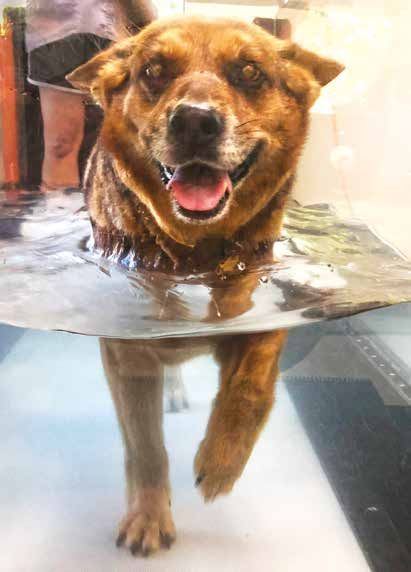
Almost immediately after my youngest dog, Sirius, had surgery on both of her knees last year, I brought her to see a physical therapist. This certified animal rehabilitation specialist created a personalized conditioning and rehabilitation plan for Sirius. One of the most useful modalities of treatment that Sirius received was hydrotherapy. It allowed her to maintain all the muscle she had developed in her Rally Obedience and agility training prior to her knee injury – and best yet, she loved the underwater treadmill. Sirius had one physical therapy session per week for eight weeks and was cleared to resume normal activity just 10 weeks post-surgery.
About 10 months later, my 10-year-old Cattle Dog-mix, Charlotte, went from walking multiple miles a day and training in sports to not being able to get up – overnight! We carried her into an emergency vet clinic where she was diagnosed with a herniated disc. We were told she would never walk comfortably again and that we should be thinking about of end-of-life decisions.
Two days later we brought her to the same veterinary rehabilitation specialist who worked with Sirius; we doubted the dire prognosis we had been given for Charlotte and weren’t ready to give up on a dog who had been so vigorous so recently! Through a combination of therapeutic treatment modalities, which included twice weekly hydrotherapy for the first month, Charlotte also made an (almost) complete recovery and was cleared to do everything she loves: hiking, swimming, long walks, trick training, etc.
I credit so much of my dogs’ recovery to hydrotherapy and skilled certified veterinary rehabilitation specialists.
HOW HYDROTHERAPY HELPS
Canine hydrotherapy is a beneficial treatment modality for dogs recovering from many orthopedic injuries, as well as degenerative conditions like arthritis, because allows dogs to move while bearing little or no weight on an injured limb. A less commonly considered benefit of the treatment is increased self-confidence for a dog who is injured or old.
Hydrotherapy isn’t dogs just splashing around in a pool, and the healing potential for injured dogs can’t be achieved by just bringing your dog somewhere for a recreational swim. There are two primary modalities of hydrotherapy treatment that dogs might receive: working on an underwater treadmill and therapeutic swimming. “The added resistance from water is excellent for increasing cardiovascular fitness, while providing low impact resistance muscle training,” says Marti Drum, DVM, Ph.D.
Dr. Drum is a Diplomate of the American College of Veterinary Sports Medicine and Rehabilitation (ACVSMR), a Certified Canine Rehabilitation Practitioner, and a Clinical Associate Professor in the Small Animal Clinical Sciences Department at the University of Tennessee, Knoxville. She is also the acting service chief of the physical rehabilitation service at the University of Tennessee Certificate Program for Canine Rehabilitation – and a huge fan of hydrotherapy!
[post-sticky note-id=’396304′]UNDERWATER TREADMILL
The underwater treadmill used by veterinary specialists looks a lot like a fish tank. During treatment, your dog will enter the treadmill (sometimes with a life vest on) either on her own or with a certified technician. The dog enters the glass tank when it’s empty, and then the door is closed and the tank is slowly filled with warm water (between 80° and 94° F).
The depth of the tank is adjusted according to the dog’s size, her specific injury, and how far along she is in the recovery process. If the therapist determines that she should be bearing no weight whatsoever, the tank is filled to a level that enables the dog to float with her paws just barely touching the treadmill. The lower the water level, the more weight she will bear on her limbs.
Once the water reaches the desired depth the treadmill floor begins moving at the speed determined by the specialist. When this happens, most dogs naturally will begin walking – even dogs who are experiencing too much pain or are too weak to walk on land often begin moving in the underwater treadmill because of the support and buoyancy the water provides. Depending on where the individual dog is in her recovery process, jets may be used to add increasing levels of resistance and the speed of the treadmill can be adjusted to support building muscle or to maintain muscle.
In addition, says Dr. Drum, “The treadmill belt itself helps encourage a rhythmic gait to facilitate gait retraining.” This was certainly the case with my Charlotte, who had to be carried into the clinic, but a few days later, was able to walk comfortably in the underwater treadmill.
While walking on the underwater treadmill and walking on land are both low-impact forms of exercise, practitioners see stronger results for dogs who are able to exercise in underwater treadmills. The added resistance from the water helps dogs gain more muscle tone than from walking on land.
The water also supports a dog whose balance has been impaired. The support provided by the water enables and encourages dogs to move their joints in a nearly normal full range of motion. Plus, dogs who need to lose weight can burn more calories by working on an underwater treadmill than they can on land.
THERAPEUTIC SWIMMING
The second modality of canine hydrotherapy is therapeutic swimming, where dogs are gently guided into a small, heated pool and supported in swimming by a certified canine rehabilitation specialist. They are generally fitted with a canine life jacket, and dogs who are prone to ear infections may also be fitted with a canine “swim cap” that prevents water from entering their ears.
While beneficial to many dogs, therapeutic swimming isn’t an appropriate treatment for every injury. When swimming, most dogs primarily propel themselves through the water by using their front legs, so it wouldn’t usually be appropriate for dogs who have shoulder or front limb injuries, Dr. Drum says, as it can aggravate those conditions and slow recovery. Hydrotherapy may not be appropriate for dogs with groin injuries (strains of the iliopsoas muscle), either.
BENEFITS
Dogs with back, hip, and knee injuries often benefit from hydrotherapy, as do dogs who are recovering from surgical repair of injuries. And hydrotherapy is increasingly recommended as a useful treatment modality for proactively conditioning for canine athletes and working dogs.
But dogs don’t need to have an injury to benefit from hydrotherapy. Dr. Drum says osteoarthritis is the most common condition she sees treated with hydrotherapy. Older dogs who have arthritis constitute about half of the hydrotherapy patients that Dr. Drum sees, and she describes the benefits to these dogs as “profoundly positive.” Senior dogs who suffer from arthritis pain often experience decreased energy and activity, which can result in loss of muscle mass and weight gain – which, in turn, increases the stress on the already compromised joints.
Dr. Drum says, “It is not uncommon that our senior and geriatric patients experience a rejuvenation simply from starting a good hydrotherapy routine,” no more than once or twice a week, but at least once every two weeks. “You have to ‘use it or lose it’ to maintain muscle and cardiovascular fitness,” she says.
When my active, well-conditioned dog Charlotte was recovering from a herniated disc, she was unable to walk on land and quickly grew depressed and even more anxious than she is ordinarily. But during her hydrotherapy sessions, her confidence and happiness visibly increased as she discovered that she could move in the water without pain, and this seemed to give her more confidence as she slowly regained the ability to walk and move on land as well.
[post-sticky note-id=’396306′]TREATMENT PLANS
Hydrotherapy will likely be only part of the treatment your dog receives. Dogs who are recovering from injury or surgery are likely to need multiple modalities of treatment in order to achieve optimal recovery. Hydrotherapy treatments are often provided in conjunction with structured exercises both at therapy sessions and for owners to follow-up with at home between sessions.
Anti-inflammatory and/or pain medications are usually prescribed, at least initially. Other holistic treatment modalities such as acupuncture and laser therapy may also be offered and provided by your dog’s rehabilitation specialist.
CERTIFICATIONS
If you think that your dog might benefit from hydrotherapy treatment, you can either ask your general-practice veterinarian for a referral, or schedule a consultation and evaluation with a certified veterinary rehabilitation specialist on your own. If you find a practitioner on your own, however, be aware that not all people who are offering these services have the same amount or type of training.
It’s increasingly easy to find dog trainers, massage therapists, and even veerinary practices who offer “canine conditioning” classes or workshops that include swimming in a therapy pool. If your dog simply needs help with weight loss, zero-impact exercise, or conditioning, these services may be just fine.
But if your dog is recovering from an injury or surgery, her therapy would be best guided by a professional with as much education and hands-on training and experience as you can find. It’s important to utilize hydrotherapy for an injured dog only under the supervision of specialized veterinary professionals who can determine whether the therapy is right for your dog, and to create an individualized treatment plan for your dog’s specific health needs.
If they are not certified specialists, the therapy they provide for your dog may be at best ineffective and at worst cause more injuries or prolong healing. As just one example, a common mistake for those not properly trained is to leave a dog on the treadmill for too long, which can result in the dog becoming sore and prolonging healing.
For injured or post-surgical dogs, look for certified rehabilitation practitioners – people who have completed specialized training on top of their DVM or veterinary nursing degrees. Dr. Drum advises that owners look for specialists with one of the following credentials:
- Certified Canine Rehabilitation Practitioner (CCRP). (Dr. Drum especially likes the program at the University of Tennessee that offers this certification.)
- Certified Canine Rehabilitation Therapist (CCRT). (Dr. Drum favors the University of Florida’s program for this certificate.)
- Certified Canine Rehabilitation Assistant (CCRA) or Certified Canine Rehabilitation Veterinary Nurse. People with this certification can provide services under the supervision and guidance of a rehabilitation-certified veterinarian.
DUE DILIGENCE
Because hydrotherapy is such specialized treatment, there aren’t certified practitioners in every community and you may have to travel to find appropriate treatment for your dog.
Finally, no matter what services you are seeking for your dog, always ask for (and check) a practitioner’s references, and read any online reviews left by former clients.
Canine Seizures

Seizures are not common in dogs – but they aren’t rare, either. The Veterinary Information Network estimates that the prevalence in the dog population is about 1%. While distressing to witness, they are rarely life-threatening. After you’ve gotten past the shock of the event and your dog is coming out of the seizure, your mind will be racing. What caused the seizure in the first place? Does your dog have epilepsy? Is this going to happen again? Turns out, these are not always easy questions to answer.
“Epilepsy” refers to a seizure disorder in which all other possible causes have been eliminated; it is a diagnosis of exclusion. The seizures seem to occur spontaneously, with no underlying structural brain disease or metabolic illness. This means that there is no test that will identify epilepsy. Rather, all other causes must be ruled out before this diagnosis can be made. Doing this can be an extensive and pricey process.
Certain breeds are predisposed to epilepsy, including Beagles, Poodles, Boxers, Labrador Retrievers, Golden Retrievers, Border Collies, and Shelties. While the disease may have genetic roots, it can also occur spontaneously in any dog.
[post-sticky note-id=’395589′]WHAT IS A SEIZURE?
Seizures occur when neurons in the brain rapidly discharge over and over again. Gamma aminobutyric acid (GABA) is a neurotransmitter in the brain that inhibits excitation of neurons, and in a seizure, the GABA receptor system is particularly involved. When seizures occur, normal GABA inhibition is overcome, and the brain cannot “calm down.” The increased electrical activity leads to changes in behavior, which can manifest in many different ways.
The classic seizure type, once called grand mal, is now referred to as tonic-clonic; tonic refers to the stiffening of the dog’s muscles and clonic refers to the dog’s twitching or jerking. Strong muscle contractions occur, the dog is unable to stand, and may lose bowel and bladder control. The dog may also vocalize.
The hallmark of a true seizure is the post-ictal period. Once the muscle contraction ceases and the seizure is over, a dog will take some time (from minutes to hours) to return to normal. In some cases, blindness and disorientation can persist for a day or more. Behavior may be very strange, such as a complete disinterest in food or ravenous eating. Difficulty walking may also occur. Your dog may sleep deeply or be restless.
Other seizure types include focal seizures (also called petit mal), in which only one part of the body is involved (such as the face); the muscles in that area may twitch or contract. In absence spells, during which a dog is conscious but not responding, the eyes may be open, but he may not answer when his name is called or he is touched. These types of seizures may presage tonic-clonic and can go unnoticed, because they are often subtle.
In most cases, these electrical discharges are self-limiting, meaning the seizure will cease on its own. In occasional cases, the seizure does not end, leading to a condition called status epilepticus (see sidebar, page 7).
DIAGNOSTICS
To reach a diagnosis of epilepsy, a thorough work-up will be necessary. At the initial examination, your veterinarian will gather a history.
Be prepared to answer questions about the duration and severity of any seizures you have witnessed, as well as any precipitating events that you noticed, such as stress, excitement, or sleeping. Toxins or medications in the house are also an important piece of the puzzle. While seizures are distressing to see, getting a video for your veterinarian could help with the diagnosis. Once your dog is in a safe position, try to record the event.
After history-taking, your veterinarian will examine your dog. This nose-to-tail exam will help identify any abnormalities that may point toward a diagnosis. Once completed, the diagnostics start.
Initially, a “minimum database” of diagnostic tests is recommended. This includes a complete blood count (CBC), chemistry panel, and urinalysis. Depending on your dog’s age, a blood pressure measurement and x-rays may also be recommended. These will identify underlying metabolic causes that can lead to seizures, such as extremely high blood sugar (as in diabetic ketoacidosis) or kidney failure related to antifreeze ingestion.
CAUSES OF SEIZURES
The cause of seizures can be broken down loosely into age groups:
Puppies younger than 6 months.
It is uncommon for a dog to develop true epilepsy before six months of age. In dogs this young, other causes are much more likely. These can include everything from parasitic infection with protozoa such as Neospora species, to viruses such as canine distemper virus, to toxin exposure (a common problem in curious puppies).
A thorough work-up for a puppy with seizures will include the minimum database above, as well as recommendations for the following (depending on breed and history):
- Bile acid test. This is done if a liver shunt is suspected. Liver shunts are abnormal blood vessels that interfere with proper metabolism by the liver. When present, they can cause seizures and abnormal behavior, especially after meals. Yorkshire Terriers, Maltese, Bichon Frises, and Miniature Poodles are all predisposed.
- Titers for infectious disease. Canine distemper virus (CDV), the fungi Cryptococcus and Coccidioides, and protozoal diseases such as neospora and toxoplasma can all cause seizure activity.
- Computed Tomography (CT) scan or magnetic resonance imaging (MRI). These tools for imaging the brain can determine whether structural abnormalities like hydrocephalus (a condition where cerebrospinal fluid builds up in a dog’s skull) or Chiari malformation (structural defects in the base of the skull and cerebellum, the part of the brain that controls balance)are present.
- Cerebrospinal tap. This can help identify meningitis, as seen with inflammation or infection.Work-ups can be expensive and time intensive, so many owners opt to treat with medications and wait to see how the dog responds. With puppies, though, epilepsy is an unlikely cause, which means another disease may be at work and will likely progress and worsen.In puppies, it is also imperative to rule out exposure to toxins. Puppies are naturally inquisitive, and this often leads to accidental exposure to medications, cleaning products, and even illicit drugs.
Dogs 6 months to 5 years.
At this age, an absence of other clinical symptoms or known toxin exposure makes epilepsy the most common cause. This is especially true in predisposed breeds. As a result, once the minimum database has been completed and obvious causes such as toxins ruled out, many owners opt to treat with anti-seizure medications and see how a patient responds.
Dogs older than 5 or 6 years.
In dogs older than 5 years, the most common cause of acute onset of seizures is generally a brain lesion, particularly brain tumors (masses). These are usually benign meningiomas, which can cause problems due to pressure on adjacent structures.
The recommended diagnostics are similar to other age groups, starting with the minimum database. In this group, though, it’s also important to rule out hypertension (by checking blood pressure) and undetected cancer (by taking chest and abdominal x-rays) as possible causes.
TREATMENT
The treatment for seizures is evolving. First-line therapy remains drug management. These medications are referred to as anti-epileptic drugs (AEDs). Phenobarbital and potassium bromide have long been the drugs of choice, but other medications are now becoming popular. These include Keppra (levetiracetam) and Zonegran (zonisamide).
Phenobarbital has been used in the management of human seizures for many years. It is reliable, effective, and relatively cheap. However, phenobarbital is a controlled medication and should be handled with care. It must always be stored away from children.
Phenobarbital works on the dog’s GABA receptors, helping to inhibit the excitation of neurons.
Phenobarbital does have significant side effects. It can cause ravenous appetite, weight gain, increased drinking and urinating, and induction of liver enzymes. In rare cases, it can cause liver failure. As a result, liver values should be monitored closely (at least every six months) by your veterinarian. If liver enzyme elevations occur, a newer seizure medication may be recommended.
The dosage of phenobarbital must be individualized, so monitoring the dog’s phenobarbital levels is critical. This is usually initiated about two weeks after starting the medication, when it is expected to reach “steady state” levels. (A drug is at a steady state when the intake of the drug is at an equilibrium with its elimination.) At therapeutic levels, it can cause sedation and ataxia. Usually, dogs will acclimate to this over time.
About 85 to 90% of dogs will experience a significant reduction in seizure activity with phenobarbital.
Potassium bromide is also considered a first-line treatment, although this is shifting. Potassium bromide has many of the same side effects of phenobarbital and must also be monitored, as toxicity is possible. It can take up to four months for this medication to reach steady state levels.
Diet is an important part of therapy with potassium bromide. Food with higher levels of sodium can increase the excretion of potassium bromide, leading to lower levels and increased seizure activity. The dog’s diet must be consistent while on this medication.
Levetiracetam is being used more frequently to treat seizures. Initially, it was used in humans, and its use has been extrapolated to dogs. Its mechanism of action is not well understood, but it may affect the release of neurotransmitters. It is minimally metabolized by the liver, so it doesn’t cause the liver enzyme elevations that are seen with phenobarbital. Levetiracetam levels in the blood are therapeutic within about 24 to 36 hours (versus two weeks for phenobarbital).
Levetiracetam also does not cause ravenous appetite and weight gain. It is considered so safe that regular monitoring is not usually necessary. It is important to note that two formulations are available and each must be given in different ways. “Regular” Keppra must be given every eight hours; Keppra-XR, an extended release formulation, can be given every 12 hours but cannot be crushed and placed in food (doing so would thwart the mechanisms that cause the drug to be released continuously over a 12-hour period).

Zonisamide does not act as quickly as Keppra but is faster than phenobarbital (about one week to reach steady state). Like Keppra, zonisamide generally has minimal effects on the liver. It does, however, have some rare side effects such as hepatopathy (liver congestion), dry eye, bladder stones, and hypothyroidism. Regular bloodwork monitoring is generally not necessary, but any changes in a dog’s condition should always be brought to the attention of your veterinarian.
Unfortunately, medications are often a life-long necessity. Working closely with your veterinarian to taper to the lowest dose possible for management is the best approach.
ALTERNATIVE THERAPIES
Products containing CBD (cannabidiol, a phytochemical compound extracted from cannabis plants) are becoming popular with owners as an adjunctive therapy for many illnesses. It is important to know that currently, other than in a handful of states, veterinarians are not allowed to recommend or discuss CBD as a treatment (see “Know Your CBDs,” WDJ August 2019).
[post-sticky note-id=’396295′]A study published in the Journal of the American Veterinary Medical Association (“Randomized blinded controlled clinical trial to assess the effect of oral cannabidiol administration in addition to conventional anti-epileptic treatment on seizure frequency in dogs with intractable idiopathic epilepsy,” June 1, 2019) evaluated CBD as an additional treatment in patients with intractable seizures.
While the use of CBD was associated with a significant decrease in seizure activity, further investigation is warranted before therapeutic recommendations can be made. As laws change, your veterinarian may be able to discuss this with you. Use caution when choosing to administer CBD products without veterinary supervision, as neither the side effects nor interactions with other, FDA-approved medications are well understood.
In 2015, a study supported the use of medium chain triglycerides (MCT) as a dietary supplement to decrease seizures. The diet studied was ketogenic (high fat, low proteins and carbohydrates). There are a few commercial diets available that address this need and may be helpful in managing seizures.
Nutritional supplements such as omega-3 fatty acids, thiamine (vitamin B1), vitamin E, and s-adenosyl methionine with milk thistle may also have some benefit when used in conjunction with standard Debra Canapp treatment. Much of the knowledge we have in veterinary medicine about these supplements is extrapolated from human medical studies and anecdotal. However, the supplements are unlikely to cause harm. As always, consult with your veterinarian before adding any supplements to current treatments.
Lastly, several studies have demonstrated possible benefit with the use of acupuncture. The exact reason acupuncture may help lower seizure frequency is not understood. The theory is that acupuncture stimulates the release of inhibitory neurotransmitters, therefore “calming” the brain. While it is not typically first-line treatment, in patients with intractable seizures or those with poor response to medications, it is another modality that may offer some relief.
After nine years in emergency medicine, Catherine Ashe, DVM, now works as a relief veterinarian in Asheville, NC, and loves the GP side of medicine.
Relishing the Ricochet
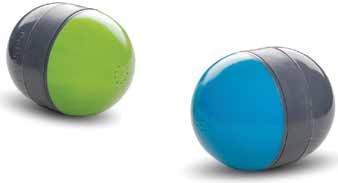
I first saw this toy – actually, a set of two – at a trade show. I had no clue what they did, but they didn’t look that interesting, either.
But then a company representative approached and asked if I knew what the toys did. “Nope!” I replied. “Show me!” He depressed a hidden button on one, and it emitted some chiming notes. Then he pressed the button on the other egg and it, too, chimed – and then started making some electronic chirping sounds. “The toys are paired through a Bluetooth connection,” he explained. “One makes an intermittent noise until it is jostled; then it goes silent and the other egg starts making a noise. Once your dog figures out how they work, you can put the eggs up to 30 feet apart from each other and your dog can have fun running from one to the other!”
Okay, now I was intrigued. I know many dogs like to play with toys that make electronic sounds, such as the Wobble Wag Giggle Ball. The concept of a toy consisting of two pieces that take turns interacting with your dog – that’s more than twice the fun! I couldn’t wait for my dogs to try the Ricochet.
THE RICOCHET EXPERIENCE
The toys are meant to be enjoyed by one dog at a time, and in fact, don’t work well when more than one dog is in the game at the same time. The sounds they make “ricochet” from one egg to the other when the noisy one is moved; if more than one dog is playing, the bouncing of the sound from one egg to the other can’t be predicted or chased.
We gave the Ricochet to six different dogs to play with; each was intrigued by the noises the toys made and intuitively nudged the toys with their noses or paws. The bigger dogs all tried to pick up the toys in their mouths and crack them open; play with these toys has to be supervised and sometimes redirected. (My large dogs could definitely bite open the toys if permitted.) But even our six-pound test dog enjoyed pushing the toys around.
Another reason to join your dog in playing with the Ricochet toys: At some point, every dog would fixate on the toy closest to them, disregarding its silence and the increasingly frantic tones of the other toy. That’s when you have to step in, taking away the one they are fixating on and getting them to listen for the chirping of the other toy. “Oh, right!” the dog will seem to say, tearing out of the room to find the other one. Then you can quickly hide the one you took away, so your dog can have fun looking for it when it starts chirping again.
The length of time that our test dogs played with the toys varied by temperament. A 6-year-old female Golden Retriever would have played with the toys until they were dead. My 12-year-old mixed-breed male, Otto, grasped the game very quickly – but lost interest the moment I stopped actively encouraging him to leave the non-chirping toy and look for the one that was making noise. All the other dogs were in between.
PRODUCT DETAILS
The toys each are about four inches long and made with a hard plastic case; the ends are covered with a softer, rubbery substance that keeps the toys from making a horrendous clatter as a dog knocks them about.
The toys can be turned off by pressing a hidden button on each egg. If you don’t turn them off, they will occasionally chirp, finally turning themselves off after 60 minutes without motion.
Each egg requires three AAA batteries. PetSafe says the batteries will last for about a month of daily use. The Ricochet comes with a one-year warranty when purchased new from an authorized seller. PetSafe offers a satisfaction guarantee, returning your purchase price (less shipping cost) if you return the toy within 45 days.
Mixed Results from Reaching Out to Pet Food Companies About DCM
Long-time WDJ contributor Mary Straus and I are working on some articles about the cases of canine dilated cardiomyopathy that have been discussed in every dog-related setting for many months now. One of the next issues of WDJ will contain the first of the pieces that we have been collaborating on. But I just thought I would share something interesting that I noticed in the process of gathering information from various pet food companies.
We wanted to see what sort of response a consumer might get from writing to pet food companies about a problem with their foods. We went to the websites of 39 pet food companies and looked for email addresses to send a note to, and found, to our surprise, that only seven listed any kind of email address. Instead, the majority of companies offer a web form for consumers to fill out – you know, the kind of thing where you fill in your name, email address, perhaps phone number, and then a comment/question, and then hit “submit.”
Why did I find this interesting? Because it leaves the consumer with no way to prove they had ever sent a letter or question to the company! Or provide them with a dated copy of the letter or question they sent!
My letter to pet food companies
This is the letter I sent to the 39 companies:
“Hello, I am trying to gather information about the response of pet food companies to the FDA’s announcements/updates about the apparent increase in cases of canine DCM, especially in dogs who have been fed diets containing peas and other legumes, potatoes, and sweet potatoes.
Your company was among those whose products were named in reports to the FDA by consumers as being potentially implicated in their dogs’ disease.
Would you please tell me if or how your company has chosen to respond to the news of this issue? Have you made any changes to any of your formulas? If so, what were those changes, and to which/how many of your products?
If you have not made any changes to your formulas, could you explain your justification for this?
If you have already released a pertinent response, could you please direct me to or send me a copy of that statement?”
Responses to my inqueries
I received responses from 25 of the 39 companies. Now, take this with a grain of salt, because I made a custom email address for the companies to respond to, and it’s possible that at least some of the companies wrote back because the email address clearly identified the inquiry I sent them as being from Whole Dog Journal (InquiryFromWholeDogJournal@gmail.com). Also, within a few days, five companies sent me personalized responses, based on the fact that my inquiry had been forwarded to someone at the company that knew me, either from manufacturing site tours or meetings at pet product trade shows or something.
Also, I received phone calls from representatives of three companies, each of whom I had met personally at some point in the past. My cell phone number was present in the letter I sent to each company, but only people with whom I had spoken in years past actually called me to discuss the letter I sent.
I received what appeared to be automatically generated responses from 24 companies – the kind of email that says, “We got your note, we’ll get back to you within 48 hours (or some such).” And like I said, one company’s representative called me right away, and two more called me within a few days, and about five more responded within days with a personalized response. But two weeks later, six of the companies who responded with these automatic responses still have not gotten back to me. At least (most of them) provided toll-free phone numbers to call if I was interested in getting a quicker response.
Of the 19 companies whose responses I have not yet described, a few were so generic as to be completely useless, or suggested that I call the company instead. For example:
“We would be happy to speak to you about this matter… Our Customer Care Specialists may be reached at 888-XXX-XXXX.”
How about this one? It sounds like the company is addressing my inquiry, because it uses some of the same words in my inquiry, but it doesn’t answer anything I asked! “We appreciate you bringing your concern regarding the canine Dilated Cardiomyopathy and we are happy to answer your inquiry. Please know that as a leader in pet nutrition, we stand behind the safety and quality of all our foods and meet or exceed every major food quality and safety standard including those issued by the FDA, USDA (U.S. Department of Agriculture) and AAFCO. We also have not been contacted by the FDA regarding any cases involving our products.” (The response was longer, but didn’t address any of the questions that I asked.)
By the way, of the three companies whose representatives (including two company owners) who called me in response to my inquiry, none had spoken with anyone from the FDA regarding the cases of DCM that had reportedly implicated or mentioned their products. The two company owners I spoke with told me that they had tried to reach someone at the FDA, but had zero success.
I’m happy to report that a few companies did respond directly to my questions. The rest tended to refer me to statements on the company websites that they had already prepared in response to the issue well ahead of my inquiry. Those statements, of course, don’t necessarily answer my questions directly.
Try It Yourself
I’ll be trying to reach the companies again via their toll-free numbers and will report on whether that effort is more or less successful.
I will admit a bias toward companies that have phone numbers on their labels and websites and email addresses on at least their websites, to make it as easy as possible for consumers to reach them in case of a dog food-related health issue. And of course, my bias is even stronger toward companies who are staffed with knowledgeable people who can respond appropriately and directly to inquiries in a timely manner. Don’t assume for a second that this rules out all the so-called boutique pet food companies, or qualifies all the giant pet food stalwarts.
Try it yourself! Write to or call your favorite dog food company and ask something simple, such as “Have you always included taurine as a supplement in your dog diets? Do you do so now?” or “Can you tell me how much taurine, or cysteine and methionine, is in (name of food you feed your dog)?”
If you ask the latter question – and they have an answer! – make sure you ask also whether the amount is expressed “as fed” or on a “dry matter basis.”
Let us know how it goes!
Agree to Disagree
There’s an old joke about dog trainers: What’s the only thing you can get two dog trainers to agree about? That the third one is doing it wrong!
I would submit that it’s not just dog trainers who often have strong opinions about the right and wrong ways to do things with dogs. And I think you would have to agree, especially if you have ever entered into a discussion about, say, grain-free dog foods, raw diets, Flexi leashes, electric shock collars, fat dogs, dogs with long toenails, dogs who bark, ear- and tail-cropping . . . I could keep going but you get the idea. There are so many hot-button issues in the dog world that it’s almost impossible to talk about anything to do with dogs (besides how cute they are) without getting into a heated argument.
As I write this – the last thing that needs to get done in order to ship this issue to the printer – an online hurricane has broken out regarding an essay published in the New York Times by Alexandra Horowitz, PhD., renowned book author and head of the Horowitz Dog Cognition Lab at Barnard College at Columbia University, in New York City. Horowitz posits that the practice of widespread, reflexive spay/neuter practices in this country shouldn’t be standard policy, as they irretrievably alter our dogs’ health, behavior, and personalities. She makes some good points! Even I, a long-time shelter volunteer who is strongly in favor of the standard practice of de-sexing all shelter animals before they are adopted, appreciate and agree with many of the anti-spay/neuter proposals she makes in the article. And yet, already, by midday on the West Coast, I have seen waves of hot words and “unfriending” sprees in online forums and social media as Horowitz’s piece is being shared, discussed, and argued about.
Here’s an idea: Let’s agree that more than one thing can be “right” at the same time. Let’s freely acknowledge that dogs can be trained “properly” with different methods and that they can eat lots of different diets (even really bad ones!) without shortening their lives. Let’s go so far as to propose that what is “best” for shelter dogs in my rural county – one best known for its high poverty and low education levels – should not be considered best for dogs purchased from good breeders and raised in affluent suburbs and urban areas.
Blanket judgments and one-size-fits-all recommendations don’t serve dogs (or their owners) very well. There are just too many different types of dogs and widely divergent attitudes about the place of the dog in society. I propose that we try to learn from one another, educate those who ask for education, make independent decisions regarding our own dogs’ welfare, and try to get along with friends and strangers as well as we expect our dogs to.
Why Play Is Important For Dogs
I read a recent article in The Atlantic about some scientists who taught rats to play hide-and-seek as part of a larger study about the neuroscience of play. I’m riveted by animal behavior, I’m a huge fan of play, and I find neuroscience interesting, so an article like this can send me straight down a rabbit hole of further reading, investigation, and thinking while gazing out the window.
The abstract of the study, which was originally published in the magazine Science, concludes, “The elaborate cognitive capacities for hide-and-seek in rats suggest that this game might be evolutionarily old.”
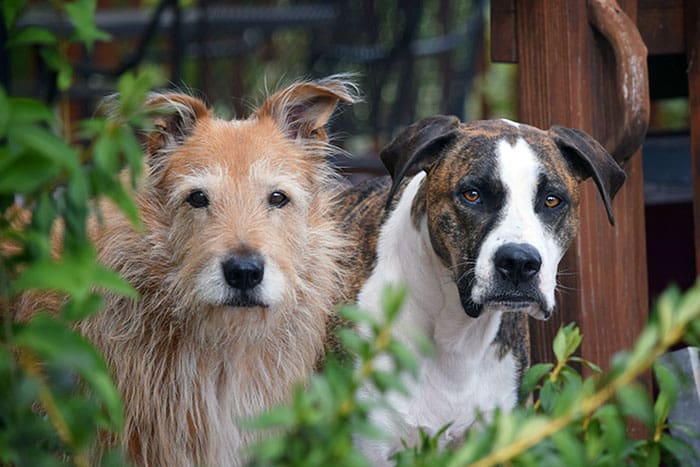
Animal behavior experts have long speculated about the purpose of play; it is thought to be a sort of behavioral practice time, when predator species practice stalking and hunting prey, and prey species practice escape tactics (such as running and dodging) and rudimentary self-defense behaviors such as kicking or biting. And of course, all species tend to engage in playful social behaviors, such as social grooming. The play of humans incorporates all of these things!
All mammals play the most when they are young, and most species spend less and less time playing as they mature. Interestingly, humans and dogs are two species who retain a greater than average interest in play well into their senior years, though the “games” may change greatly over time. This is why good dog trainers frequently recommend using play as a reinforcer for a dog’s behavior that the owner likes or wants more of. Mutually enjoyable play also helps strengthen the bond between dogs and their humans, and keeps them engaged and motivated to pay attention to and work with us.
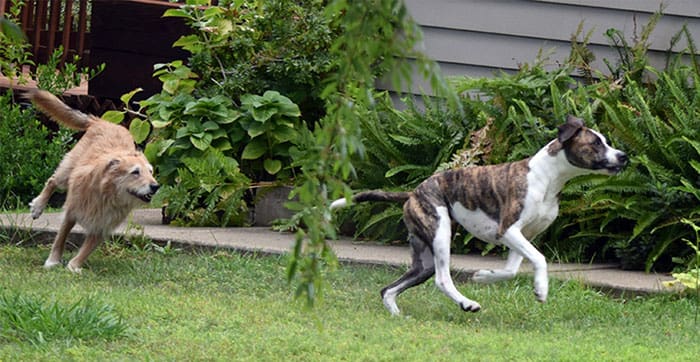
Interestingly, hide-and-seek is a favorite game of many humans and their dogs, me and mine included. Both my dignified senior dog, Otto, and my always goofy, playful four-year-old Woody will leap to their feet and stare at me if I signal the start of a game by just looking at them and then pantomiming an exaggerated sneaking out of the room: Oh, it’s on! they seem to say. They know to wait for me to whistle before starting their search, without me having to tell them to “stay.” I never taught them this, but if they come and find me before I’m actually hidden, I just tell them, “Aw, you wrecked it!” and resume doing whatever it was that I was doing before I initiated the game. So they learned that if they wait for the whistle, I’m both more difficult to find and I almost always let out that inadvertent squeal of joy and surprise that humans almost can’t help but make when they are discovered hiding by their intensely seeking dogs. And then we all celebrate with laughter and a little bit of roughhousing.
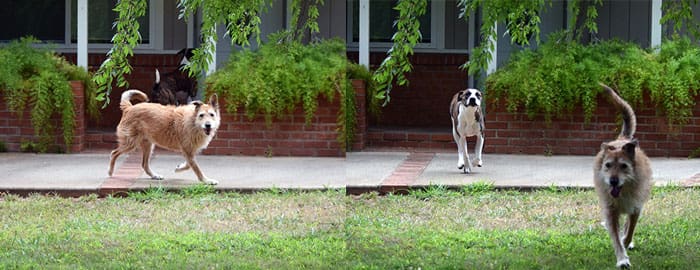
The party starts when they reach me. Good dogs!
Mutually enjoyable play is so reinforcing for most dogs, that I would hazard a guess that people who play with their dogs would rate their dogs’ behavior – or at the very least, the strength of their relationship – more highly than people who don’t play with their dogs. Shoot, if I were a scientist with time and money to spare, I’d try to find a way to test this hypothesis. Instead, I’ll just ask you guys: Do you play with your dogs? How and why?
Always Be Prepared for Emergencies
We had a little practice fire drill here last week. I mean, there was an actual fire, and the mandatory evacuations that were ordered were close enough to have me putting my “go bag” by the back door and putting the dogs’ collars on and their go bags in the car. But we didn’t have to evacuate, and the fire crews got the fire subdued within 48 hours of its eruption, so that was all good.
However, I had the opportunity to help another friend who did have to evacuate, and we learned a few lessons together.
Lesson #1: Always Have Backup Phone Numbers
When I saw the location of the fire on the maps published by Cal Fire (the fire-fighting agency that responds to all fires in California that happen in the spaces between other fire-fighting jurisdictions) on Twitter, I texted my friend Dorothy right away; she was right in the path of the thing. No response. Then I called her. The call went straight to voicemail. Lesson number one: Have backup phone numbers! I have only her cell phone number, not her home phone number, and she only carries her cell when she’s not home. So, knowing that ahead of time as I did, I should really have made more of an effort to get her home number programmed into my phone.
I decided to head to her house. Already, there were California Highway Patrol cars parked in the area, blocking access to a number of roads near her – but fortunately her road was still accessible.

As I pulled my car into the front of her house, she was just getting out of her own car. It turns out that she had just gotten home from a long day out of town and was scrambling to catch up to the whole situation (and she never turns her phone on when she’s driving). She heard about the fire on the radio as she was driving home, and heard that there were mandatory evacuations on roads very close to her home. I gave her a hug and said, “Tell me what I can do.”
I should probably mention that my friend is 80 years old. She’s a very active 80-year-old; in fact, she is my horseback-riding buddy. She has three horses and still competes in endurance races. But she also has a 92-year-old husband who is not quite as active and able as she is, three cats, and one not-very-well-trained dog. We had some work to do.
The good news: Her horse trailer is always hooked up to her truck and ready to roll. It contains a dressing room that has a place for humans to sleep and a miniature kitchen and bathroom, so the cats and dog and humans can camp out in the there, too. The bad news: It’s a two-horse trailer and she has three horses.
She told me that she would send her husband to a friend’s house to stay. She could use some help to clean out a dog crate for the cats, and to get some feed for the horses and halter them. She would look for the cats and get her own things together. She said, “I can take the two horses to Camelot (a stable, the evacuation site for large animals in our area), drop them off, and come back.” OK, we had a plan.
Lesson #2: Always Have Important Addresses On Hand
I grabbed her dog, Maddie, who was already running around barking at everything, and put her in my car. I figured Dorothy would be able to catch the cats much more easily without Maddie underfoot. I filled up a bunch of buckets with hay cubes, and put halters on the horses. I tried to check Twitter, to see how the fire fighters were progressing, but I can’t get a signal at Dorothy’s house.
I said, “Let me take Maddie to my house. I have a big crate I can put her in. I will also get news about the fire and see if I can find another spot in someone else’s trailer for the third horse. Then I will call you on your cell, or text you anything important, so put your cell in your pocket.” She agreed.
I can’t get a signal until I am about two miles from Dorothy’s house. That’s why I got a little discombobulated when I reached another friend who has horses and who might have been able to pick up Dorothy’s third horse – and I realized I didn’t know Dorothy’s address, only how to get there. Lesson two: Make sure you have the physical address of the people you are trying to help!! I could neither ask Dorothy nor look at her street sign nor the number on her fence. I explained Dorothy’s location to my friend on the phone as well as I could, and said I would call her back and let her know the address for sure. I hoped we wouldn’t need the ride for that horse, that Dorothy had enough time to take two trips.
As I drove toward my home, I realized that I had recently loaned the crate that I intended to put Maddie in to another friend, who was out of town. Yikes! So I had to drive to that friend’s house, load the pieces of crate onto the top of my car and tie it down (it’s a Great Dane-sized crate made of flat panels that get fastened together in the corners with long rods), and then drive home. Once there, I checked the fire maps online. They hadn’t changed – but whether that was because the fire fighters were holding the line or because the news hadn’t updated yet, I did not know. I texted Dorothy a few times, with no response. I left Maddie in the big crate and headed back to Dorothy’s house.

Lesson #3: Always Have Backup Keys
By now, it was pitch dark outside. But as I pulled into her driveway, I could see that her husband’s car was gone; he had already left to stay with their friends. And two of the horses were in the trailer, and the cats were in the big dog crate, in the back seat of her crew-cab truck. Good, good, good! But Dorothy looked distraught and was near tears. “I lost the key to the truck!” she told me. “I had it with me, but now I can’t find it!”
Lesson number three: Always have a backup key to your getaway vehicles!
With smoke hanging thickly in the air, we searched for almost an hour. In her house. In the barn. Down the driveway. In the car. In the cab of the truck, the back of the truck, the dressing room of the trailer. I even opened the horse trailer door, where the horses waited impatiently and looked around their feet, in case she had dropped the key while tying their halter ropes. We were nearly in despair when I found the key in a place that Dorothy had already looked: under the hay that she had thrown to the horse that we were leaving behind. The horse had been eating this whole time, and the key and its ring was nearly buried in the dirt and picked-over hay, but I have never been so happy to see a glint of metal in a horse’s food in my life.
As I write this, days later, Dorothy and I have had a discussion about our little fire drill. I have put her address and home phone number into my phone. She is having a spare key made for her truck, and is going to hide it in a location in the barn that she will disclose to her sister (who lives nearby and also has horses) and me. We both are going to post a “to do” list of things that we don’t want to forget in the event of another evacuation or emergency. (She forgot a cell phone charger and her prescriptions, which fortunately weren’t absolutely needed to survive for the two days she stayed evacuated. When I went to her house in the dark, I forgot the flashlight that sits next to my back door, and nearly ran my cell phone down to zero battery by using its flashlight function instead. Dumb!)
Important Emergency-Preparedness Link
Here in rural Northern California, wildfire is always going to be a possibility, so all of us in this situation have to keep an evacuation plan in mind – for ourselves and for all of our animals. In other parts of the country, you may have to be ready for other natural disasters: hurricanes, tornadoes, earthquakes, floods, avalanches. Even those who live in cities should have a go-bag packed and ready with certain items, and a checklist of things to take along in case of a disaster. I can tell you that there is a huge difference between how much you will forget when you are thinking about it right now, while you read this in comfort and security on your computer or tablet, and how much you will forget if you are in the dark with the smell of smoke swirling all around and your beloved pets and family counting on you to get it together. So let this be my annual reminder to you! Make a checklist! Put together a go-bag! Update your phone and address book!
Here are some emergency-preparedness links I hope you find helpful:
https://www.ready.gov/build-a-kit
https://www.aspca.org/pet-care/general-pet-care/disaster-preparedness
https://www.fema.gov/media-library-data/1553273223562-797451b5cb0bee8d35d3e4e85e3830d6/Checklist.pdf
Beware of harmful algal blooms (HABs)
There are many global environmental disasters that I am concerned about in a big-picture way, but at this time of year, the one that I am personally and most immediately afraid of on behalf of my dogs has to do with harmful algal blooms (HABs), also known as toxic blue-green algae.
When certain types of algae experience a sudden burst of growth, they can produce toxins that effectively poison the water. Animals that drink the water, inhale water droplets, or swim in the water and lick themselves later can all become sick and die from these toxins.
Staying Away Our Favorite “Watering Hole”
The town I live in has a good-sized river running through it, the Feather River, an integral component of the California State Water Project. The river flow is actually split into two halves, with half the water flowing through the center of town in the river’s historic bed, and half flowing through a canal into two shallow man-made lakes, referred to locally as the Forebay and Afterbay. There are thousands of acres of open space on either side of the river, and even more acres of land surrounding these lakes – and this is where, for 13 years now, I have been walking and swimming with my dogs. Year-round, we walk in these open spaces, referred to as the Oroville Wildlife Area, and my dogs drink, wade, and swim, no matter what the weather.

But late this summer, as in the past couple of years, there have been warnings about toxic algae keeping me away from our favorite places to cool off.
There are a few small ponds in the Wildlife area that turn brilliant green late in the summer – and I have avoided those areas like the plague; that just makes sense. Also, there are a few places on the edges of the lakes that are particularly shallow and the water is still; it’s never turned the bright green that often indicates a HAB, but it starts looking greener than normal. When I see this, I leash the dogs and we walk on until we get to places where the water looks clear.
It’s Not Just Obviously Green Water
But just this past week I read about a family who lost four of their five dogs after the dogs drank and swam in a pond on their farm in Michigan – a pond whose water looked perfectly clear! The toxin in that case was found in the mud at the bottom of the pond.
And last week, the major newspaper published in our state Capital, the Sacramento Bee, ran an article about how quickly HABs can bloom, and how quickly they can kill dogs (and small children!) who ingest the water – and how the conditions are just right for these blooms to occur in local waterways.

This has me avoiding our regular walks, taking them only to places where there are no natural water sources (carrying lots of water for them to drink instead), and only taking them to parts of the river where the flow is vigorous. I miss our favorite places, but won’t take a chance with this!
We’ve run articles about toxic algae before, here and here. Please read, and know what to look for when out walking with your dogs near water!
Additional Reading
For more information about HABs, see these sites:
https://www.cdc.gov/habs/be-aware-habs.html
What Did My Dog Swallow?
A couple nights ago, I awoke in the middle of the night to that one sound that no dog owner can ignore: that lurching sound of an impending vomit. I leapt out of bed and saw my younger dog, Woody, standing near my bed, trembling. He looked exactly like a toddler who woke up feeling crummy and sought out his mom so he could barf in front of her. Well, that’s exactly what he did do; he and my older dog Otto always sleep in the living room.
“Oh, puppy,” I said. “What happened?” I grabbed my phone and smashed buttons on it, trying to find the flashlight option through bleary eyes. I scanned the room with the light but couldn’t see any actual puddles of vomit, so I got up and walked him outside, in case he had to throw up some more. He walked out onto the lawn and peed, went to the outside water bucket and drank a little water, and then came back inside. No more trembling. He settled back onto the couch and I went back to bed.

In the morning, with clearer eyes, I found the vomit. It was, of course, on one of the only two rugs in the house, an antique Persian carpet runner in my bedroom. In the weak beam of my phone flashlight, I couldn’t differentiate between the pattern in the rug and the small (now mostly dried) puddle. There was some slimy stuff that was most certainly just digestive juices, bits of nearly digested kibble, and . . . a blob of something. I used some paper towel to pick it up, examining the blob closely.
A mystery from the depths…of Woody
At first I thought it was a piece of bone or glass, but it was soft, with rounded edges. It was rubbery – if not actual rubber. I took it to the kitchen sink and rinsed it off. It was for sure a hunk of something rubbery and opaque. I could make out some molded edges.
If this happened two or more years ago, I wouldn’t have even blinked. Woody chewed up lots of things when he was a puppy and adolescent dog, and he vomited up everything that was indigestible, usually within a day or two. I had a few surprises – as when he vomited up a piece of something I hadn’t even known was missing – but mostly I was able to say, “Ah, that’s a piece of that old Kong toy,” or “Finally, that chunk of the flying disk he ruined.”
But this time? He hasn’t chewed up anything for ages and ages. I can’t even remember the last time he chewed up a toy or a forbidden item. And I don’t at all recall any toy that we have ever had that was this particular color, a sort of a slightly translucent, light root-beer-bottle brown.
Could this thing have been in there for months or years? Is that even possible? Perhaps, once upon a time, it was colorful and had sharp edges from being chewed up, and it has lost color and gained smooth edges from marinating in digestive juices for years?
This was the theory proposed by my husband, anyway. “What are you talking about, he never chews up anything anymore?” he asked me, incredulous. “He chews up his Squeak balls all the time!”
On the hunt for damaged toys
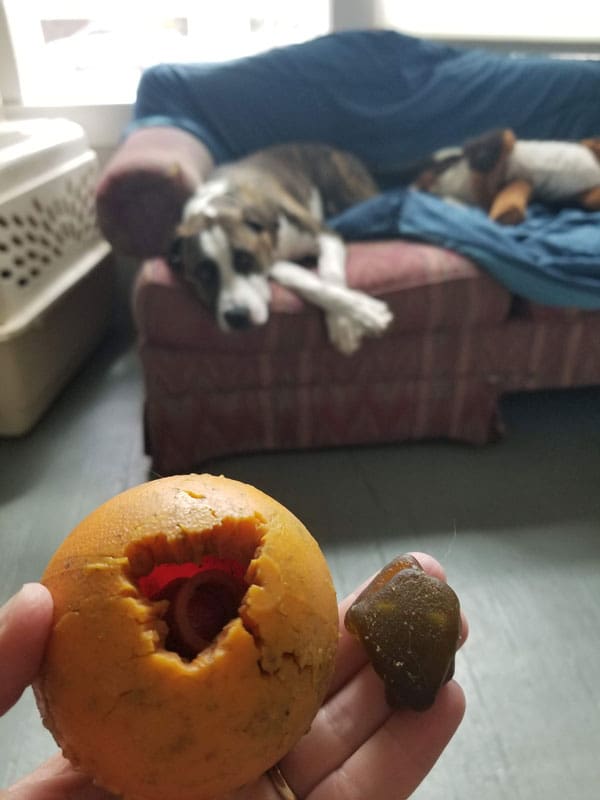
That is not exactly correct. Both of my dogs like to chew on their favorite toy, the Planet Dog Squeak Ball, like they are chewing bubblegum. The Squeak appears to be the perfect texture, or offers the perfect amount of resistance for their jaws. But I don’t think either dog is exactly bent on destroying the Squeak balls; they just chew the balls so much, that eventually, the balls crack and start to fall apart. And when they start to fall apart, then one of the dogs (usually Otto) will lay down with the ball and chew it up into bits. It’s a process that takes months, but that goes fast at the end.
To test my husband’s theory, I hunted around the property, looking for all the Squeak balls in various stages of repair. I did actually find one that had a missing chunk that was vaguely the same shape as the perplexing lump from Woody’s midnight misadventure. But, no: It wasn’t a credible match. The baffling item is about twice as thick as the “walls” of the Squeak.
So the mystery lives on. What is that thing? How long has it been in there? Where did it come from? Is there more in there? I might never know.
Dogs!!


